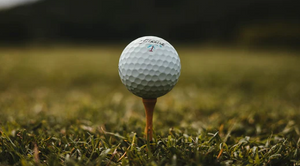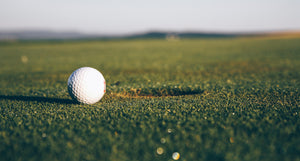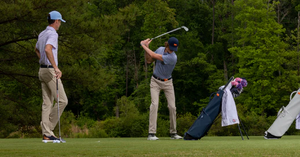Putting Grip: Which Style Is Right for You?
Whether you are a beginner stepping onto the green for the first time or a more advanced golfer, putting is challenging to master. But it’s a necessary skill if you want to win your rounds - and that's where putting grip comes in.
While having a putter is essential, understanding how and why different grip styles might work for you is crucial. Although all require some trial and error, finding the method that works for you is all part of the fun of making your game your own. So read on to find the perfect grip for you!
The 5 Most Common Types of Golf Putting Grips
1. Conventional Putting Grip
Also known as the reverse overlap method, to execute this, place your left index finger on top of your right pinky finger, then perform the style as you would the traditional overlap grip style. This stance means that the club runs down the palms, not the fingers, providing a sense of unity.
Benefits of The Conventional Grip
While golf is about having fun and getting out on the green, for pro golfers and more advanced golfers alike, it’s also about winning your round, and sometimes the most simple grip is the most effective. Most golfers will start with this grip and alter their technique if needed. It’s natural, comfortable, and unlikely to put you off your game.
Who Is the Conventional Grip For?
If it’s good enough for Tiger Woods, it’s good enough for beginners and advanced players. While advanced players might want to try other methods, this is the better grip for beginners. Once you’ve mastered this, you can move on to other techniques, but should those not suit you, you’ll always have the conventional style to fall back on.
2. Left-Hand Low Grip Style (or the Cross-Handed Grip)
While not as common as the conventional grip, the left-hand low grip is a strong runner-up among the pros on tour. Opposite to the traditional method, the left-hand goes on first for right-handers, and the left thumb sits on the side of the shaft with hands facing the hole, giving control to your left hand.
Benefits of The Left Hand Low Grip Style
This style lets you put your dominant hand in a position to help provide more power to the club without losing control of the clubface. It’s important to note that this would change to the “right-hand low grip” for left-handed golfers. An additional benefit is the grip’s ability to level the shoulders at address so the putter stays low throughout the stroke.
Who Is The Left Hand Low Grip Style For?
This style is top-rated among those who have too much wrist hinge. The left-hand low grip is a suitable replacement for the conventional grip. Try this style if you also struggle with distance control or shorter putts.
3. The Claw Grip
The claw grip is less popular than the first two grips but remains popular on the green. Your dominant hand comes almost entirely off the club, preventing you from closing the club face unintentionally. The claw has several variations, which goes to show the versatility and creativity of golf. Still, the critical idea is (if right-handed) to place the left hand in the top position and the right hand holding the handle of the club between your thumb and forefinger, palm facing your waist.
Benefits of The Claw Grip
When used correctly, the claw grip is excellent for providing extra stability. You remove the chance of your dominant hand getting too excited to close on the ball as your left hand, arms, and shoulders guide it.
Who Is The The Claw Grip For?
This grip is excellent for eliminating chances of yips (involuntary spasms of the wrists) that might cause you to close on the ball sooner than you’d like and with less control. It might raise a few eyebrows as it’s certainly a different look, but it’s commonplace enough not to feel self-conscious. It might take some trial and error, so if you’re looking to win your next round, you might want to practice a little first.
4. Prayer Grip Style (or the Palm-Facing Grip)
The prayer style is a newer method of putting grip, so named because your hands look like you are praying around the top of the club. This style is surprisingly simple: place your hands at the same level as each other with palms facing. Your thumbs should both be on the grip and facing down with your index fingers running down the shaft.
Benefits of The Prayer Grip
While unorthodox, the prayer style will help place your shoulders in a more neutral position, and because your palms are facing each other, you can squeeze the shaft between your hands if you want more excellent stability. The setup allows your body to drive the putter more than your wrists.
Who Is The Prayer Grip For?
Theoretically, this method is only feasible if you have a large shaft. Once you have a large enough grip, you can see if this style works for you. It’s best suited for people who want a neutral pendulum stroke. If you struggle with too much movement, the prayer style can help to smooth out any creases.
5. Wrist Lock Grip Putting Method
The slightly less dramatic version of the arm lock-putting method, this style has several variations. However, it’s best to start by placing your left hand near the bottom of the grip, with your left forearm pressing against the handle by the right hand.
Benefits of The Wrist Lock Grip Putting Method
If you’re a fan of the claw method, you may like the wrist lock style, which almost eliminates the dominant hand’s impression on the stroke and the influence of the least dominant hand. This style will force you to use your arms and shoulders to create the stroke.
Who Is The Wrist Lock Grip Putting Method For?
If you’re looking for more bodily control, this is the method for you. Eliminate any yips, and get the pendulum swing style that you want. If your hands tend to tense, you might find the wrist lock more comfortable, allowing you to play a better game.
Remember, a comfortable grip is vital to perfecting short putts every time. While it’s best to work through the other styles first if you’re a beginner, this method could be the answer to remove your wrists from influencing your stroke.
What Grip Should I Use for Putting?
Firstly, you must choose the right putter for you because your putter will make a difference to your putting and overall game. Every golfer is different, and with golf expanding to include more demographics on popular television and in competitions, it’s clear that it will only keep growing.
While the conventional style is one of the most popular due to how comfortable it is and how beginners can also master this grip quickly, it doesn’t mean it’s the method for you. Start with the conventional method, but move on to another if it doesn’t work after some practice. Most importantly, once you’ve mastered the traditional style, consider expanding your toolbox by learning a new method. You never know; it could be even more helpful!
Frequently Asked Questions
How Do I Choose a Putter Grip?
As a beginner, set yourself up for success and try the conventional grip first. But after that, you can try different styles until you find the one that works for you. Every golfer is different, so you’ll need to embrace a bit of trial and error.
How Do Most Pros Grip Their Putter?
Bryson DeChambeau enjoys an arm lock, Tiger Woods the conventional style, and Jordan Spieth the left-hand low. Even among the pros, every player is different and has different preferences. The beauty of golf is that you can play the game your way, allowing for diverse grip styles.
Final Thoughts
No matter how you grip your putter, playing the style that suits you, your body, and your game best would be best. You're spoiled for choice with a range of methods to choose from!
So get out on the green today and get practicing, but don’t forget to protect your putters with putter headcovers so your equipment and game are always at their best. Discover how Stitch Golf can help you today!



